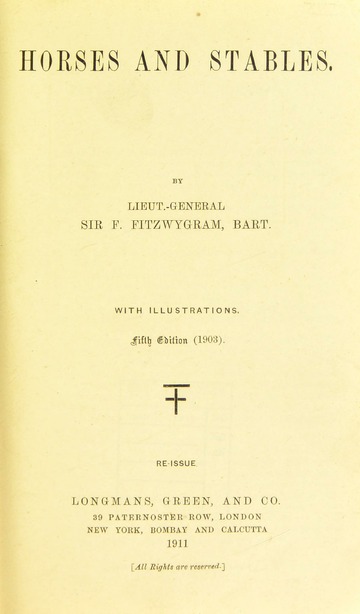
|
L’ouvrage est entièrement numérisé et disponible sur le site : |
||||||||
|---|---|---|---|---|---|---|---|---|---|
| Horses and stables — 1903 / FITZWYGRAM Frederick John, 1903 | |||||||||
Horses and stables by Lieut.-General Sir F. Fitzwygram, Bart. With illustrations.
Fith edition
/
FITZWYGRAM Frederick John
|
|||||||||
|
|||||||||
| Français |
« The Author desires to acknowledge with very warm thanks the valuable assistance
which he has received from Y. Colonel J. Drummond-Lambert, C.B., Late Director-General
Army Veterinary Department, in bringing this Edition up to date.
The principal changes in the present (5
th
) Edition are — In Chapter 1, on Ventilation, the Air-brick under manger is struck
out; it is retained over the manger, page 7. The other means of ventilation remain
as before. Par. 18b, Moss Litter. Chapter 24, Influenza : Some considerable change
has been made in treatment. Chapter 29, Glanders and Farcy. Do. do. Chapter 50, Grease
and Cracked Heel. Do. do. Par. 633, Side bones, not caused by calkins. Par. 876, Aging
of Horses : When some teeth show more wear than others, the age is generally gauged
by the younger looking- teeth. Par. 931, Dishing : A “dishing” horse usually stands
with his Toes turned in. To counteract this, he should be shod, so that during progress
he will carry them straight. To this end he should be shod with a shoe quarter of
an inch wider than the Crust on the outer quarter; but the shoe on the inside should
be made about quarter of an inch narrower than the Crust; and the Crust must be rasped
down to fit the shoe. The Clip of the shoe must not be placed in the centre of the
front, but about three-quarters of an inch towards the outer side. Par. 1021, Navicular
disease, cause of.
With reference to Mr. Blunt’s very interesting letter in the Postscript : Indian experience,
I believe, thoroughly supplements his experience. The Arab of the Desert, though thorough-bred
on both sides, is not reproduced on either side of the Persian Gulf. The progeny grows
15 to 16 hands high, but loses all the best qualities of tho Arab. I had a hope that
first-class Arabs brought to this country and kept on dry soil and fed on hard food
might have blessed Mr. Blunt’s patriotic endeavour to produce the true Arab of greater
stature. But it has not been so, and I am sorry for it. » Présentation de l’éditeur
(1903)